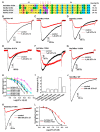Purification and Characterization of JZTx-14, a Potent Antagonist of Mammalian and Prokaryotic Voltage-Gated Sodium Channels
- PMID: 30308978
- PMCID: PMC6215091
- DOI: 10.3390/toxins10100408
Purification and Characterization of JZTx-14, a Potent Antagonist of Mammalian and Prokaryotic Voltage-Gated Sodium Channels
Abstract
Exploring the interaction of ligands with voltage-gated sodium channels (NaVs) has advanced our understanding of their pharmacology. Herein, we report the purification and characterization of a novel non-selective mammalian and bacterial NaVs toxin, JZTx-14, from the venom of the spider Chilobrachys jingzhao. This toxin potently inhibited the peak currents of mammalian NaV1.2⁻1.8 channels and the bacterial NaChBac channel with low IC50 values (<1 µM), and it mainly inhibited the fast inactivation of the NaV1.9 channel. Analysis of NaV1.5/NaV1.9 chimeric channel showed that the NaV1.5 domain II S3⁻4 loop is involved in toxin association. Kinetics data obtained from studying toxin⁻NaV1.2 channel interaction showed that JZTx-14 was a gating modifier that possibly trapped the channel in resting state; however, it differed from site 4 toxin HNTx-III by irreversibly blocking NaV currents and showing state-independent binding with the channel. JZTx-14 might stably bind to a conserved toxin pocket deep within the NaV1.2⁻1.8 domain II voltage sensor regardless of channel conformation change, and its effect on NaVs requires the toxin to trap the S3⁻4 loop in its resting state. For the NaChBac channel, JZTx-14 positively shifted its conductance-voltage (G⁻V) and steady-state inactivation relationships. An alanine scan analysis of the NaChBac S3⁻4 loop revealed that the 108th phenylalanine (F108) was the key residue determining the JZTx-14⁻NaChBac interaction. In summary, this study provided JZTx-14 with potent but promiscuous inhibitory activity on both the ancestor bacterial NaVs and the highly evolved descendant mammalian NaVs, and it is a useful probe to understand the pharmacology of NaVs.
Keywords: NaChBac; mammalian NaVs; peptide toxin; pharmacology.
Conflict of interest statement
The authors declare no conflict of interest.
Figures






Similar articles
-
Spider Knottin Pharmacology at Voltage-Gated Sodium Channels and Their Potential to Modulate Pain Pathways.Toxins (Basel). 2019 Oct 29;11(11):626. doi: 10.3390/toxins11110626. Toxins (Basel). 2019. PMID: 31671792 Free PMC article. Review.
-
A novel tarantula toxin stabilizes the deactivated voltage sensor of bacterial sodium channel.FASEB J. 2017 Jul;31(7):3167-3178. doi: 10.1096/fj.201600882R. Epub 2017 Apr 11. FASEB J. 2017. PMID: 28400471
-
Molecular surface of JZTX-V (β-Theraphotoxin-Cj2a) interacting with voltage-gated sodium channel subtype NaV1.4.Toxins (Basel). 2014 Jul 23;6(7):2177-93. doi: 10.3390/toxins6072177. Toxins (Basel). 2014. PMID: 25055801 Free PMC article.
-
Structure and function of hainantoxin-III, a selective antagonist of neuronal tetrodotoxin-sensitive voltage-gated sodium channels isolated from the Chinese bird spider Ornithoctonus hainana.J Biol Chem. 2013 Jul 12;288(28):20392-403. doi: 10.1074/jbc.M112.426627. Epub 2013 May 23. J Biol Chem. 2013. PMID: 23703613 Free PMC article.
-
A complicated complex: Ion channels, voltage sensing, cell membranes and peptide inhibitors.Neurosci Lett. 2018 Jul 13;679:35-47. doi: 10.1016/j.neulet.2018.04.030. Epub 2018 Apr 21. Neurosci Lett. 2018. PMID: 29684532 Review.
Cited by
-
Spider Knottin Pharmacology at Voltage-Gated Sodium Channels and Their Potential to Modulate Pain Pathways.Toxins (Basel). 2019 Oct 29;11(11):626. doi: 10.3390/toxins11110626. Toxins (Basel). 2019. PMID: 31671792 Free PMC article. Review.
-
Molecular mechanism of the spider toxin κ-LhTx-I acting on the bacterial voltage-gated sodium channel NaChBac.Front Pharmacol. 2022 Aug 4;13:924661. doi: 10.3389/fphar.2022.924661. eCollection 2022. Front Pharmacol. 2022. PMID: 35991876 Free PMC article.
-
Venom-derived peptides for breaking through the glass ceiling of drug development.Front Chem. 2024 Sep 26;12:1465459. doi: 10.3389/fchem.2024.1465459. eCollection 2024. Front Chem. 2024. PMID: 39398192 Free PMC article. Review.
References
Publication types
MeSH terms
Substances
LinkOut - more resources
Full Text Sources

